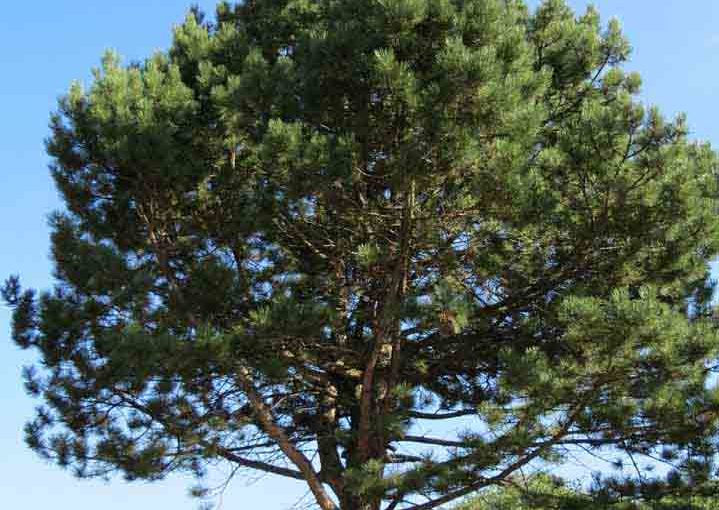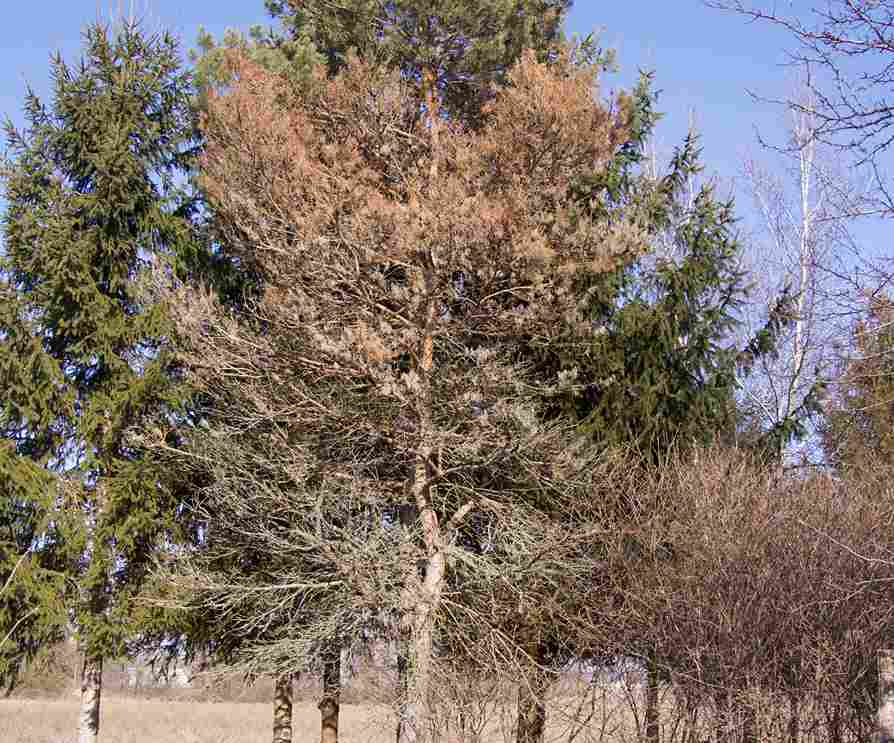Noticeable needle loss or discoloration in pine trees could be a sign of a diseased tree. But what disease, and how can you treat your pine tree to restore it to health? So, if you’re asking yourself why your pine trees are turning brown, in this article, we’ll detail 10 common pine tree diseases and how to treat them.
We also have included a tree care expert’s comments on how to get your pine tree looking green again. After all, pines are evergreen trees, which means a healthy pine should stay green all year long.
Has your once-proud Austrian pine started looking a little under the weather recently? Have sections of it begun turning an unsightly brownish-yellow hue that ruins its formerly rich green appearance? If so, your tree may be suffering from a common affliction known as Dothistroma needle blight.
While losing some of the vibrancy and fullness of your Austrian pine can certainly feel upsetting, there is hope! This disease is treatable if caught early. Arm yourself with the right knowledge, and you can nurse your pine back to health.
In this article, we’ll cover what causes Dothistroma needle blight, how to identify it, and most importantly, what you can do to save your Austrian pine and restore its natural beauty. Read on to give your tree the care it needs to thrive once again!
What Is Causing the Decline of Your Austrian Pine?
Dothistroma needle blight is the likely culprit behind your pine’s sickly appearance. This infectious fungal disease targets over 50 types of pines, but Austrian pines are particularly susceptible.
The main symptoms to look out for are
- Browning/yellowing needles, especially in the lower branches first
- Premature needle drop
- Thinning foliage that appears tufted or sparse
- Dead shoots and branches
- Reddish-brown spots or bands on needles
If you notice these issues on your Austrian pine, there’s a very good chance Dothistroma needle blight is to blame. But what causes this common pine tree disease?
The Culprit: Mycosphaerella Pini
Dothistroma needle blight is caused by the fungal pathogen Mycosphaerella pini (also known as Dothistroma septosporum) This aggressive fungus infects pine needles, gradually killing them
It tends to target older needles first before moving up to younger ones. As more needles die off and fall prematurely, the tree becomes less able to photosynthesize. Without the energy it needs growth becomes stunted and branches start dying back.
Given time, Dothistroma can significantly weaken and even kill affected pines if left unchecked. Catching it early is key to saving your tree!
How Does Infection Occur?
Mycosphaerella pini fungal spores spread through wind and rain splash. Given the right conditions, they infect pine needles through natural openings or wounds.
Once inside, the fungus colonizes the needle tissue. Small tan spots emerge at first, then develop into reddish-brown bands or lesions. Severe infections cause the needles to turn yellow/brown and drop.
Wet, cool weather promotes fungal growth and spread. Infection risk is highest during spring and fall when nights are cold but daytime temps are mild. Overcrowded trees and poor air circulation also increase susceptibility.
Now that you know the cause behind your Austrian pine’s illness, let’s discuss how to nurse it back to health!
Reviving Your Austrian Pine: Treatment Options
The good news is Dothistroma needle blight can be managed with prompt treatment. Several approaches can be taken to cure your sick pine and restore its former elegance:
Remove Infected Needles
Start by pruning off any dead needles and shoots to reduce the fungal inoculum. Rake up fallen debris around the tree’s base. Burning or burying this material will help minimize reinfection next season.
Improve Air Flow
Thin nearby trees to open up air space around your Austrian pine’s branches. Allowing more sunlight penetration and air circulation will create a less hospitable environment for Mycosphaerella pini.
Apply Fungicides
Applying commercial fungicides containing chlorothalonil, mancozeb, copper, or propiconazole can protect healthy needles from infection. Start applications in spring as new shoots emerge. Repeat every 7-14 days following label instructions.
Water at the Base
Avoid excessive needle wetness by watering your pine at the base only. Never use overhead sprinklers, which encourage fungal growth. Allow needles to dry fully before nightfall.
Manage Weeds/Undergrowth
Keep weeds, brush, and undergrowth cleared away from the tree’s base. This improves airflow and reduces conditions favorable to the pathogen.
Fertilize Lightly
Boost your pine’s vigor with light fertilization in mid-spring. Avoid excess nitrogen, which creates succulent growth vulnerable to infection. Focus on well-balanced, slow-release formulations.
Consider Preventive Sprays
In fall, apply horticultural oils to overwintering needles. This helps suppress spore production and may limit next year’s infections. Always test first for phytotoxicity.
Monitor and Re-Treat as Needed
Keep a close eye on your Austrian pine’s health and retreat as necessary. Consistent, proactive care offers the best chance of full recovery.
By taking a multi-pronged approach, you can beat back Dothistroma needle blight and restore the splendor of your pine. Be vigilant, patient, and persistent – you may be amazed at its transformation over time.
Take Heart – You Can Have a Healthy Austrian Pine Again
While Dothistroma needle blight can be discouraging, there are always reasons for hope! Catching it early and taking prompt action gives your Austrian pine an excellent chance of rebounding.
With consistent monitoring and care, its natural beauty can be restored. Take things step by step, focus on the fundamentals, and let nature take its course.
Even if progress seems slow at first, don’t lose faith. Many Austrian pines make a full turnaround within a few seasons when properly treated. Yours can too with a little TLC!
Some final tips for supporting your pine’s recovery:
-
Strive for optimal growing conditions – well-drained soil, sufficient sun, ample space.
-
Keep it well watered during droughts to avoid added stress.
-
Talk to your local garden center or tree specialist for advice on fungicides.
-
Remove heavily damaged branches only as needed to maintain the tree’s form.
-
Be patient – a full recovery takes time. Focus on incremental improvements.
With persistence and care, the days of having a healthy, vibrant Austrian pine on your property will return. Don’t give up hope! By understanding what causes these common pine tree issues and taking action, you can be rewarded with a revitalized evergreen specimen once again gracing your landscape.

Brown Spot Needle Blight

Brown spot needle blight is a pine tree disease that causes a large problem for longleaf pine seedlings and Afghan pines grown in Christmas tree nurseries. Symptoms occur months after infestation and can spread rapidly in permitting weather conditions.
Pine trees affected:
- Longleaf
- Afghan
- Mugo
- Japanese black
- Virginia
- Eastern white
- Red
- Austrian
- Scots
Symptoms: Circular gray-green spots appear on the pine needles in the fall. The spots then enlarge and form narrow brown bands encircling the needles. The needles then die and fall off.
Causes: Brown spot needle blight is caused by the fungus Lecanosticta acicola (formerly Mycosphaerella dearnessii). It spreads only in wet weather. The splashing of rainwater enables the spores to spread rapidly and infect large areas of the tree. Contaminated pruning tools can also spread this disease.
This fungus, along with other pathogens, is also associated with white pine needle disease (WPND).
Treatment: Prescribed and managed fire burning every two or three years eliminates the infected needles and kills the infectious spores. Professional fungicide sprays can also control the fungus.
The Michigan State University Extension recommends applying fungicide when new needles are about half-grown between May and June and applying a second spray three weeks later.
Seasons: Symptoms appear in the early fall. The fungus spreads during warm, wet summer months.
Risk level: Nursery seedlings are most susceptible to infection when in the grass stage and will often die from brown spot needle blight. The disease can kill young pine trees that have been infected year after year.
Can a Dying Pine Tree Be Saved?
At a certain point, the tree can not be saved. If you see the entire tree changing colors or sap running down, make it a point to act. It is likely too late to save that tree, but you might be able to save other trees and plants around it.
How to Save Your Diseased Pine Trees
FAQ
What is killing my Austrian pine trees?
What causes a pine tree to die suddenly?
What is the problem with the Austrian pine tree?
